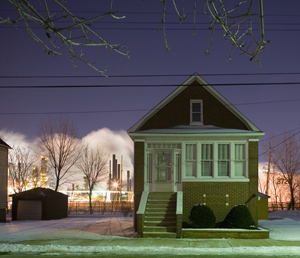Home alone
Doctoral student David Schalliol, AM’04, photographs Chicago-area isolated buildings, capturing neighborhoods in flux.
By Ruth E. Kott, AM’07
Photography by David Schalliol, AM’04

The BP refinery behind this Whiting, Indiana, home prompts the viewer to consider the relationship between industry and its neighbors.
View the slideshow.
A three-story brick building on Stony Island Avenue and 70th Street, the lone survivor of a once-major commercial strip, is the home of King Richard’s Tire and Hub Cap Shop. On 63rd between Langley and Champlain, underneath the “L” tracks, the boxy, neutral-toned Greater St. Titus Church announces its name in bright-red block letters.
Photographer and urban-sociology doctoral student David Schalliol, AM’04, shot these images for his Isolated Building Studies project, a series of mostly Chicago residential and commercial buildings, multistories and one flats with no neighboring structures. The sparse scenes represent neighborhoods in transition—new development, shuttered community institutions, or demographic shifts, says Schalliol, who has been capturing these moments of change since 2006.
Many of his subjects are dilapidated, with chipped paint and boarded windows. Yet, because he frames each photo the same way, even the new buildings he shoots, with their “pristine but unadorned” facades, carry the same melancholic, sentimental tone.
Each photo in the series, comments one user on the Flickr site where Schalliol posts his images, has an “urban-house-ripped-out-of-context-y” feel. An out-of-place structure creates confusion, says Schalliol, causing viewers to wonder, why is it isolated? He composes each photo to “increasingly suggest” to observers “that they might question what’s going on there.” Many are titled on Flickr using simple descriptors: “Residential Building” or “Fire Damage.” He tries to explain general context, including the photo’s date, its approximate location, and sometimes a map.
The buildings do tell individual stories—like the Wood-Maxey-Boyd House at 2801 S. Prairie Avenue, designed by Chicago architect John C. Cochrane. Once part of a prestigious 19th-century residential street, it survived urban renewal efforts in the 1950s and ’60s. But as a series they tell a broader tale, one of a community in ruins or of a new investment elsewhere. Schalliol sees destruction and creation as the same societal process: how the built world interacts with human life around it. Yet he includes few people in his images: “I have kind of a complicated relationship with having people in photographs.” Concerned about exploitation, he prefers photos that hint “at other forms of human action,” such as an “L” train in the background or a car out front.
Schalliol first experimented with cameras as a high-school student in Indianapolis. “I started my photographic education in the early 1990s,” he told Chicago web publication Gapers Block (where he is managing editor), “by burning through rolls of film documenting the Midwest hardcore/punk scene while exploring central cities and liminal rural/suburban places.” He didn’t realize it then, but his drive to capture something interesting in the physical world and his interest in sociology emerge from the same place, he says. “I’m motivated in the same way that any social scientist is, in helping to better understand the world around us, and the social world in particular.”
“You don’t have to be a visual sociologist to appreciate” Schalliol’s photos, says Chicago sociology lecturer Sharon Hicks-Bartlett, AM’85, PhD’94, “or even someone with a great knowledge of photography. By looking at them as a collection or group, you can draw” conclusions. Photography is a democratic medium, speaking to academics and nonacademics alike, says Hicks-Bartlett, which allows photographic research to be used in multiple ways, including as fine art: Schalliol exhibits his Isolated Buildings series at the Steenbock Gallery in Madison, Wisconsin, through April 8 and at the Hyde Park Art Center this fall.
Photography can also stretch the boundaries of traditional sociology, says Schalliol. With so many online databases—Flickr and Google Street View, for example—he believes his discipline can adopt these new technologies to compile and analyze visual research. “Far more images than have ever been created in human history are available now.”
He regularly adds new photos of isolated buildings to Flickr, sometimes three or four in a day, sparking conversation among his fans. “There’s a legacy with his prints,” says Hicks-Bartlett, so viewers understand what he wants to communicate. “Definitely a survivor,” one commenter wrote of a residential, red-brick, two-story building near Washington Park, sandwiched between two open lots. Schalliol agreed: “Imagine what it’s witnessed.”
WRITE THE EDITOR
DISCUSS THIS ARTICLE
E-MAIL THIS ARTICLE
SHARE THIS ARTICLE
WEB EXTRA
RELATED READING
- A Visual Sociology article by Howard S. Becker, PhB’46, AM’49, PhD’51, on visual sociology, documentary photography, and photojournalism
